Plasma/Plasmoids/uk: Difference between revisions
Created page with "Після з’єднання з комп’ютером зовнішнього носія даних або завантаження нового носія у пристрій..." |
Created page with "Крім того, праворуч від кожного з пунктів буде показано невеличку піктограму, яка відповідатиме ..." |
||
| Line 15: | Line 15: | ||
[[Image:Device_Notifier_Widget.png|295px|center]] | [[Image:Device_Notifier_Widget.png|295px|center]] | ||
Крім того, праворуч від кожного з пунктів буде показано невеличку піктограму, яка відповідатиме стану доступності (або «змонтованості») пристрою. Пристрій можна від’єднувати від комп’ютера без жодного ризику втрати даних, лише якщо він перебуває у стані демонтування. Якщо натиснути цю піктограму, носій даних буде демонтовано і/або виштовхнуто з лотка, якщо цей носій було змонтовано, і змонтовано, якщо носій ще не змонтовано. Зауважте, що демонтування або виштовхування може зазнати невдачі, якщо файли з носія даних ще відкрито у якійсь програмі, наприклад, якщо копіювання якогось великого файла ще не завершено. Здебільшого, достатньо трошки зачекати, а потім повторити спробу. | |||
Clicking anywhere in the shaded box around the device name (but not on the eject/unmount icon if present) pops up a dialogue box with a list of possible actions that make sense for that device. Simply select one and click on OK or hit the Enter key. Double-clicking also works. The Cancel button dismisses the pop-up without taking any action. | Clicking anywhere in the shaded box around the device name (but not on the eject/unmount icon if present) pops up a dialogue box with a list of possible actions that make sense for that device. Simply select one and click on OK or hit the Enter key. Double-clicking also works. The Cancel button dismisses the pop-up without taking any action. | ||
Revision as of 13:29, 24 December 2010
Віджети Плазми
Тут наведено список деяких з віджетів. Інші віджети Плазми можна встановити з інших джерел. Якщо вам потрібна довідка зі встановлення віджетів, зверніться до цієї сторінки.
Віджети для роботи з системою
Сповіщення про пристрої
Програму Сповіщення про пристрої призначено для обробки дій з портативними носіями даних, зокрема флеш-носіями USB, цифровими фотоапаратами, зовнішніми жорсткими дисками USB тощо. Ця програма також допоможе вам під час завантаження оптичного носія даних до пристрою читання компакт-дисків або DVD.
Після з’єднання з комп’ютером зовнішнього носія даних або завантаження нового носія у пристрій читання буде відкрито контекстне вікно Сповіщувача (це вікно можна відкрити і безпосереднім натисканням піктограми на панелі). Вікно залишатиметься відкритим доки на нього буде наведено вказівник миші, якщо відвести вказівник миші з меж вікна, його буде закрито за декілька секунд.
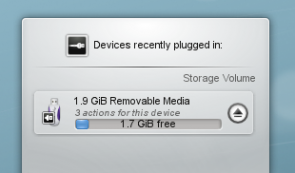
Крім того, праворуч від кожного з пунктів буде показано невеличку піктограму, яка відповідатиме стану доступності (або «змонтованості») пристрою. Пристрій можна від’єднувати від комп’ютера без жодного ризику втрати даних, лише якщо він перебуває у стані демонтування. Якщо натиснути цю піктограму, носій даних буде демонтовано і/або виштовхнуто з лотка, якщо цей носій було змонтовано, і змонтовано, якщо носій ще не змонтовано. Зауважте, що демонтування або виштовхування може зазнати невдачі, якщо файли з носія даних ще відкрито у якійсь програмі, наприклад, якщо копіювання якогось великого файла ще не завершено. Здебільшого, достатньо трошки зачекати, а потім повторити спробу.
Clicking anywhere in the shaded box around the device name (but not on the eject/unmount icon if present) pops up a dialogue box with a list of possible actions that make sense for that device. Simply select one and click on OK or hit the Enter key. Double-clicking also works. The Cancel button dismisses the pop-up without taking any action.
Weather Widgets
Weather widgets are especially popular if you live in a country with very changeable weather, such as the U.K.
LCD Weather Widget
The LCD weather widget gets its information from one of three sources, the BBC weather from the UK Met. Office, NOAA's National Weather Service, or Environment Canada. If it can locate a weather station near you it will give you a range of details about the current weather.
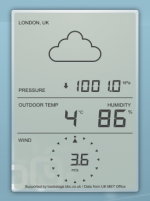
It can also be installed to the Task-bar, in which case you get an icon-size display which simply shows the current outside temperature.
Productivity Widgets
Pastebin Widget
This useful tool can be made quite small, to save desktop space, but is invaluable when you need to show a configuration file or screenshot which is too big to be accepted by email. It's also perfect for use with an IRC query.
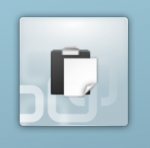 |
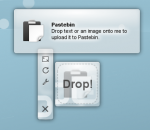
|
To use it, simply drag the required file onto the widget. The widget will then show 'Drop!'. When you drop your file it will give the URL for accessing it from the server, and can copy it to the clipboard for you. You can also drag images from other applications (such as KSnapshot, which is very handy for screenshots) or text that you have highlighted. You can also middle-click on the widget to send the currently selected text.
It uses both Pastebin and Imagebin servers and these are configurable via the widget's configuration dialog.
PowerDevil
A battery icon sits in your panel. According to your choice of configuration, it can display the remaining amount of charge, or display it when you hover over it. Click on the battery and you get the summary display, while clicking on the Configuration button ![]() takes you to a full configuration screen (click to view enlargement of images).
takes you to a full configuration screen (click to view enlargement of images).
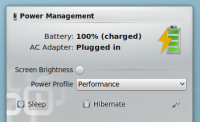 |
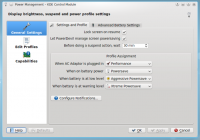 |
A further screen allows you to define and manage a number of profiles, and the final screen gives a summary of your computer or laptop's power-saving capabilities.
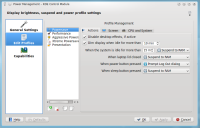 |
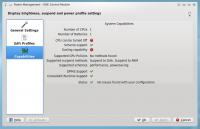 |
Finally, PowerDevil configurations can be set from Krunner, as described in detail here.
More information on configuration options can be found in this Fedora page.
![]() Support for this application can be found from the project's home page
Support for this application can be found from the project's home page
